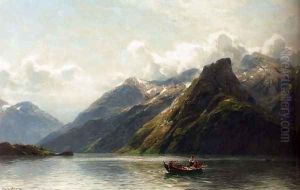Karl August Heinrich Ferdinand Oesterley Paintings
Karl August Heinrich Ferdinand Oesterley, born in 1805 in Göttingen, Germany, was a distinguished 19th-century German painter, primarily known for his landscapes and architectural paintings. Oesterley's artistic journey was deeply influenced by the Romantic movement, which emphasized emotion and individualism as well as glorification of the past and nature, seeking a deeper understanding of the soul through the beauty of the surroundings.
Oesterley’s education in the arts began at the University of Göttingen, where he initially studied theology before turning his focus entirely to painting. His transition from theology to painting illustrates a broader 19th-century trend where art became a medium for spiritual and emotional expression, aligning well with the Romantic ideals. Throughout his career, Oesterley traveled extensively across Europe, drawing inspiration from various landscapes and historical sites, which he masterfully incorporated into his works. His travels not only enhanced his palette with the diversity of European landscapes but also deepened his understanding of historical architecture, contributing to the authenticity and richness of his architectural paintings.
Though not as widely recognized today as some of his contemporaries, Oesterley's contributions to the Romantic movement were significant. He was adept at capturing the transient effects of light and atmosphere, a skill that imbued his landscapes with a sense of mood and timelessness, resonating with the Romantic fascination with nature's power and beauty. His architectural works, on the other hand, often depicted ruins and historical buildings, serving as a romantic commentary on the passage of time and the enduring beauty of the past.
Oesterley spent the latter part of his life in his hometown of Göttingen, where he continued to paint, teach, and inspire a new generation of artists. His works, which were mainly kept within private collections and regional museums, have occasionally been rediscovered and appreciated for their contribution to the 19th-century German Romanticism. Karl August Heinrich Ferdinand Oesterley passed away in 1891, leaving behind a legacy that, while perhaps overshadowed by more prominent figures of his time, offers a unique and profound perspective on the Romantic era's artistic endeavors.
